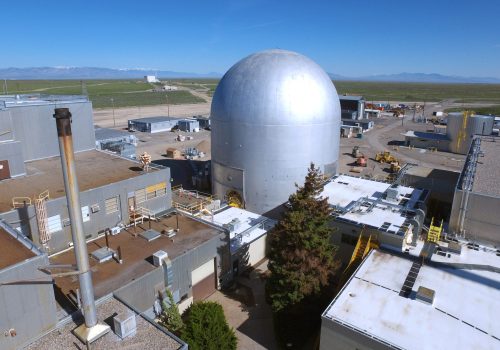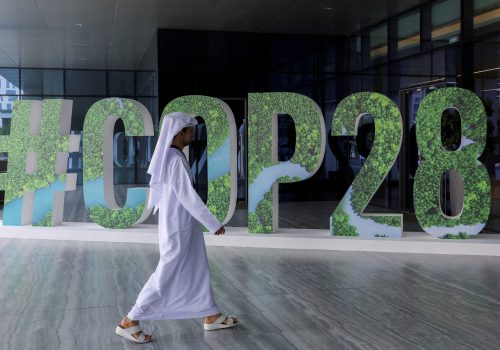John Kerry unveils a ‘critical’ new US strategy to expand fusion energy
Watch the event
US Special Presidential Envoy for Climate John Kerry on Tuesday announced a new strategy for international cooperation on the development of nuclear fusion, which he said would be—alongside other energy sources, such as wind, solar, and nuclear fission—”a critical piece of our energy future.” The strategy, Kerry explained at the Atlantic Council’s Global Energy Forum at COP28, focuses on research and development, supply-chain improvements, regulation, workforce development, and education.
If “all of our countries are threatened, and they are, [and if] all life is threatened, and it is, then we need to pull ourselves together with every strength we have,” Kerry said. “We cannot realize this grand ambition—perhaps not at all, but certainly not at the pace we need to—doing it alone.”
The need for alternative fuels such as fusion is apparent because “science clearly tells us, without any question whatsoever, that the cause of this crisis… [is] emissions. It’s the way we burn fossil fuels,” Kerry said.
Kerry noted that “we’ve had a little debate in the last few days about what the evidence shows or doesn’t show,” a reference to controversies during the United Nations Climate Change Conference in Dubai over what role oil and gas will play in the global energy future.
“We have two options,” Kerry explained. “Either capture the emissions or don’t burn [fossil fuels].”
Kerry explained that the evidence of warming across the planet makes it “clear” that the world needs to “move faster” to limit global temperature rise. “We need to figure out what we’re going to do at a critical pace,” Kerry warned.
Below are more highlights from Kerry’s remarks and the panel that followed, which touched upon the role fusion can play and how best to foster international collaboration on it.
The huge potential
- Kerry recounted having heard, as a senator for Massachusetts, that nuclear fusion—which joins two atoms together, producing energy—would be thirty years away, only to talk with scientists a decade later and be told that it was still thirty years away. But “the cadence of new and exciting fusion announcements has obviously increased over time,” he added.
- Now, he said, “there is potential in fusion to revolutionize our world and to change all of the options that are in front of us” for providing abundant clean energy to the world.
- Former US Secretary of Energy Ernest Moniz, who moderated the panel that followed Kerry’s remarks, said that “in this decade, there is a very high probability that… the conditions for sustained fusion will be demonstrated.” This, he added, “is truly a game changer—assuming this all comes to pass.”
- Designer Gabriela Hearst, former creative director of fashion house Chloé, noted the environmental impact caused by the garment industry. “We really need to focus on moving away from the fossil fuel addiction that we have,” she said. At Chloé, she explained, she had designed a collection inspired by visits to fusion labs. Fusion, she said, could help “the survival of our species.”
The accelerating pace
- Several speakers pointed out how new technologies and materials are helping realize the commercialization of fusion at a faster pace than expected. Bob Mumgaard, chief executive officer of the commercial startup Commonwealth Fusion Systems, explained that new technologies are “accelerating innovation.”
- “It’s just going faster and faster” with the help of technologies such as artificial intelligence and machine learning, Mumgaard explained. “In the last five years, it’s unrecognizable.”
- Six decades of government research and development has helped too, explained the White House’s Costa Samaras. “Now,” he added, “the challenge here is [that] energy technologies have long taken decades to get from the starting place to the market; and we do not have decades.”
- “International collaboration,” Samaras argued, will “supercharge” fusion energy development and quicken the pace toward establishing a commercial fusion plant. “That enables the advancement of fusion power… along the timeline that we need to deal with climate change.”
The remaining challenges
- Michelle Patron, senior director of global sustainability policy at Microsoft, noted that in order to meet growing energy demand, and to do it in a decarbonized way, “we need a multi-technology approach” that includes fusion and other renewable energy sources, including wind, solar, and geothermal. She added that electricity grids are local, so the mix of energy sources that countries deploy will depend on local political, economic, and social circumstances.
- Youth Survival Organization Chairman Humphrey Mrema, who is from Tanzania, said that if he were an African leader approached about supporting fusion development, he would “say no.” That’s because fusion is “hard to start” and “difficult to maintain” with the financial architecture across the continent, which has invested heavily in fossil fuels, he explained.
- In Africa, “we have to change the investment and channel it to renewables,” Mrema said. In addition, for Africa to pursue fusion, he explained, it will need technology, capacity building, and more financial resources.
- For Hearst, part of the challenge is awareness. “We live in a silo community,” she explained. “The science community has this information” about fusion’s potential, “but not the fashion community or other communities. So it’s time to cross-pollinate information to bring more hope.”
Katherine Walla is an assistant director on the editorial team at the Atlantic Council.
Watch the full event
Further reading
Tue, Dec 5, 2023
A new generation of nuclear reactors is poised to set the United States—and the world—on the path to net zero
Global Energy Agenda By
Over the next decade, more than a dozen advanced reactor concepts will be demonstrated in the United States. Ensuring the advancement of this nuclear energy will be critical to securing security, prosperity, and environmental sustainability for future generations.
Thu, Nov 30, 2023
To achieve carbon neutrality, countries must navigate geopolitics and energy together
Global Energy Agenda By
Energy dynamics, replete with their occasional turbulence, hold sway over global geopolitics. As such, multilateralism will be a key driving force to encourage energy transitions toward net zero.
Thu, Nov 30, 2023
Expert analysis: The successes and shortcomings in the fight against climate change at COP28
New Atlanticist By
Our experts dispatched to Dubai, where they analyzed how global leaders responded to the greatest challenges posed by climate change.
Image: US climate envoy John Kerry delivers a keynote address at the Global Energy Forum at COP28



